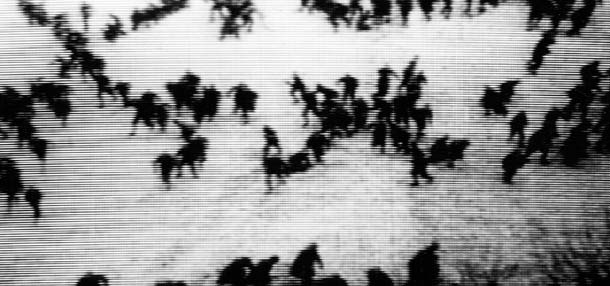| |
|||
| |
Werner
Kaligofsky |
||
| |
|||
|
 Werner Kaligofsky, "untitled (Aix-en-Provence 1940)", 1995-2001 Courtesy Werner Kaligofsky |
||
|
In his conceptual photographic work, Werner Kaligofsky explores the history of film and photographic imagery to reveal new meanings and trigger off cognitive processes. Thanks to his subtle selection of images he is able to condense deposited historical contents with more recent ones. Part of his work deals with film, the single frame or sequences of historical films selected by him on the basis of specific criteria. Another part uses photography to explore certain places and their history. Kaligofsky's approach appears to be documentary. He photographs individual images or pictorial sequences from old films that are screened on television or commercially available on video. The film image photographed from a TV screen incorporates the digital processing of the medium film. In selecting the films that he uses for his work, Kaligofsky is primarily interested in those that already contain a moment of reflection as, e.g., in Claude Chabrol's documentary "L'oeil de Vichy" that examines the propaganda films of the Vichy regime. The piece "Ceci n'est pas que vous croyez" ("This is not what you think", 1995) consists of four black and white photographs that show how the celluloid of movie films was used during the war to make shoe cream or lipstick. Kaligofsky's "o.T." (untitled), 1995 (depicted on the invitation) is based on the same film by Chabrol. A crowd of people whose bodies had formed the words "Vive Pétain" is in the process of dispersing. The piece "Lucy" (1994) (the title is taken from the main protagonist of "The Magnificent Ambersons" (1941) by Orson Welles) consists of six photographs of the credits in which Welles also shows the technical means of production of the film (cutting desk, microphone, etc.). "Kaligofsky's image is a dual reflection: both within the series and with regard to the transfer of the image from one dispositif to the other and the shifts in the fixations of moment and trace (or of fragment and gaze) that emerge in the process." (Georg Schöllhammer) Kaligofsky created the installation "Verkehrsflächen 2001" (Trafficways 2001) (2001) especially for Innsbruck. A single photograph of each of the 8 Innsbruck trafficways named after opponents and victims of National Socialism is projected onto the two facing walls in the windowless gallery room situated on the first floor. A live video picture of the "monumental national zone" (Irene Nierhaus) – more concretely, Maria-Theresien-Strasse, which is hidden behind the wall of the gallery – is projected onto the central wall that stands in between. A text is displayed next to each slide projection. It gives the viewer the name of the trafficway, the person it is named after, his/her "age, profession, political activity, manner of persecution" (Heidemarie Uhl), and information on the relevant council decisions, as well as details about residents' protests and the renamings that resulted from them. In the next room, Kaligofsky works with aerial photographs found at a flea market in Île Rousse on Corsica. These photographs, which show landscapes and industrial plants, were made in the fifties in France exclusively for educational purposes. Kaligofsky combines these aerial pictures, which he gives the title "Reproduction forbidden" with photographs from the above-mentioned film, "L'oeil de Vichy" by Claude Chabrol. These video stills show a crowd of people who, having just formed the now barely recognizable words "Vive Pétain" with their bodies, are rapidly dispersing. Title: "o.T. (Aix en Provence 1940)," 1995-2001 [shown on the invitation]. The transformation of a place in connection with new production conditions and needs is the theme of the book "Die Arbeit verschwindet im Produkt" (The Work Vanishes in the Product), 1998. From 1991 to 1995 Kaligofsky photographed the demolition of the former hat factory in the inner courtyard of a Viennese block of houses and the subsequent construction of an exhibition hall. In this documentation he is certainly not interested in representing the technical "drama" of demolition and reconstruction. His focus is on an objective documentation of a process from a few, precisely defined camera perspectives. In a sort of reversal, the photo series now takes on greater resemblance with a film still and its specific time-related characteristics. |
|||
| |
|||
|
Werner Kaligofsky was born in Wörgl in 1957 and grew up in Kitzbühel. He now lives and works in Vienna. |
|||
| |
|||
| Catalogue Ed. Galerie im Taxispalais (Innsbruck), Fotohof (Salzburg) Texts by Reinhard Braun and Monika Faber (German/English) Fotohof edition 2004, Band 43 80 p., 106 images € 15,- ISBN 3-901756-43-4 |
|||
| |
|||
|